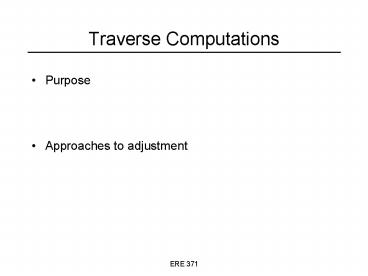Traverse Computations - PowerPoint PPT Presentation
1 / 42
Title:
Traverse Computations
Description:
210 15' 30' - 110 05' 30' = 100 10' 00' ERE 371. Directions of Traverse Lines. A ... 10053.143 m. 10015.181 m. 10000.000 m. 10058.144 m. X Coordinate. 100 ... – PowerPoint PPT presentation
Number of Views:497
Avg rating:4.0/5.0
Title: Traverse Computations
1
Traverse Computations
- Purpose
- Approaches to adjustment
2
Compass Rule Adjustment
- Procedure
3
Example Traverse
B
38.576 m
110 05' 00"
C
30.141 m
111 25' 30"
25.605 m
65 33' 30"
A
72 54' 30"
58.437 m
D
4
Balancing Angles
- Purpose
- Procedure
5
Methods for Adjusting Angles
- Several possibilities
- Selection of method
6
Equal Corrections
- Issue
- Distribute closure
7
Equal Corrections to Angles
- Advantages
8
Example Traverse Balanced Angles
B
38.576 m
110 05' 30"
C
30.141 m
111 26' 00"
25.605 m
65 33' 30"
A
72 55' 00"
58.437 m
D
9
Directions of Lines
- Use adjusted angles to compute line direction
- Azimuths or bearings?
10
Computing Directions
B
direction?
110 05' 30"
C
30 15' 30"
A
11
Compute Directions Clockwise Around Traverse
B
100 10' 00"
110 05' 30"
C
30 15' 30"
Assume or find azimuth of AB 30 15' 30"
Compute azimuth of BA (azimuth of AB ? 180)
210 15' 30" Subtract angle at B 210 15' 30"
- 110 05' 30" 100 10' 00"
A
12
Directions of Traverse Lines
13
Directions of Traverse Lines
B
100 10' 00"
C
30 15' 30"
168 44' 00"
A
275 49' 00"
D
14
Departures and Latitudes
- Departures (deps)
- Latitudes (lats)
15
Computing Departures Latitudes
- Compute by Dep L sin ? Lat L cos ?
- Where ? azimuth L length of line
North (Y)
G
?
Lat. FG L cos?
L
F
East (X)
Dep. FG L sin?
16
Example Traverse
B
100 10' 00"
38.576 m
C
30 15' 30"
30.141 m
168 44' 00"
25.605 m
A
58.437 m
275 49' 00"
D
17
Example Traverse
Departure Length x sin (azimuth)e.g. Dep. AB
30.141 m x sin(30 15' 30") Latitude Length x
cos (azimuth) e.g. Lat. AB 30.141 m x cos (30
15' 30")
18
Closure in Deps and Lats
- For mathematically closed traverse
- Geometrically closed traverse
- Closure difference between known/computed
position - Linear error of closure (LEC)
- Relative error of closure (REC)
19
Linear Error of Closure
?dep 0.0248 m
A'
?lat 0.0363 m
0.044 m
A
20
Traverse Adjustment
- Goal
- Some methods
- Arbitrary method
- Compass (Bowditch) rule
- Least squares adjustment
21
Readings
- Chapter 10 sections 10.1 10.8
22
Compass Rule Adjustment
- Application
- Works for traverses with limited number of lines
23
Compass Rule
- Proportion is rearranged for computational
efficiency
24
Compass Rule Balance Departures
Corrected departure Departure Departure
correctione.g. Corrected departure AB 15.1880
(-0.0049) 15.183 m
25
Compass Rule Balance Latitudes
Corrected latitude Latitude Latitude
correctione.g. Corrected latitude AB 26.0347
(-0.0071) 26.028 m
26
Computation of Coordinates
- General
- Application
27
Calculate Coordinates
28
Adjusted Azimuths and Lengths
North (Y)
G
?
Lat. FG
L
F
L length of line FG
East (X)
Dep. FG
? azimuth of line FG
29
Calculating Azimuths and Lengths
L length of line JK
North (Y)
? azimuth of line JK
Dep. JK
East (X)
J
?
L
Lat. JK
K
30
Compute Adjusted Azimuths/Lengths
31
Least Squares Adjustment
- Theory
- Application
- Issue
32
Understanding LS
- Advantages of LS approach
- Assumptions
33
Understanding LS
- Generally make redundant measurements
- Residual
- Difference between observation and MPV
- e.g. ?i MPV obsi
- Premise of LS
34
Example
- Measure distance five times
- 100.04, 100.15, 99.97, 99.94, 100.06
- Every observation has associated residual
- M 100.04 ?1 ? ?1 M 100.04
- M 100.15 ?2 ? ?2 M 100.15
- M 99.97 ?3 ? ?3 M 99.97
- M 99.94 ?4 ? ?4 M 99.94
- M 100.06 ?5 ? ?5 M 100.06
- LS selects M to minimize sum of squared residuals
35
Example cont.
- Want to minimize sum of residuals
- Recall from calculus
- Function minimum occurs when derivative is zero
- ?Take derivate with respect to M and equate to
zero
36
LS Adjustment of Traverse
- Components
- Measure angles and distances
- Derive MPV of point coordinates
- Observation equations
- Express observed measurements in terms of
coordinates
- Issue
- Equations are non-linear
- Normalized through Taylor expansion
37
Horizontal Traverse LS Adjustment
- Minimal input
38
Estimating Horizontal Coordinates
- Approach
39
Input File for LS Adjustment
40
Output File for LS Adjustment
- Contents of output file
- Summary of input data
- Adjusted stations
- Adjusted distances and residuals
- Adjusted angles and residuals
- Adjusted azimuths and residuals
- Associated statistics
- Quality of adjustment
- Size of all residuals
- Consider SD of unit weight
41
Output From LS Adjustment
42
Readings
- Chapter 10 sections 10.11, 10.16 10.17
- Chapter 15 sections 15.1 15.3































